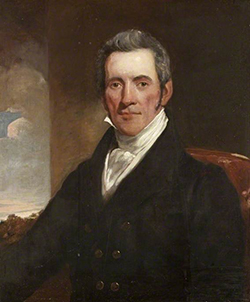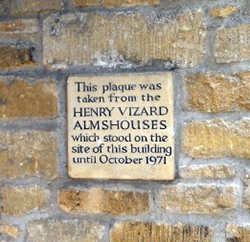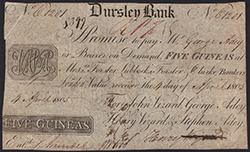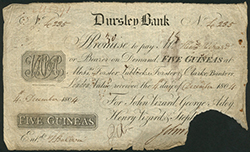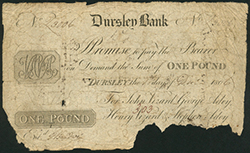Henry VIZARD 1775 - 1866
Portrait in Dursley Town Hall. Artist unknown
Fourth child of of William VIZARD 1735 – 1807 and Ann PHELPS 1744 – 1824
Born 1775
Died March 1866
Plaques
Plaques at Vizard Close, Woodmancote, Dursley, a sheltered retirement complex replacing the alms houses.
Henry Vizard was a generous benefactor and philanthropist for Dursley
1) 1834. HENRY VIZARD gave the National School house and ground, and the master’s residence.
2) In 1843, he gave four cottages and a building in Bower's Court for establishing and supporting an Infant School, and endowed it with £1000
3) In 1853, he gave six cottages and gardens for alms-houses for three men and three women, and £2000 as an endowment, to be spent in repairs, payment of taxes, and allowance to the inmates.
4) In 1855, he gave £200 to the Gloucester Infirmary, on condition that it should admit one in-patient and one out-patient annually from Dursley.
5) In 1856, he gave £500, for blankets and clothing for the poor on St. Stephen’s Day. (Boxing Day)
From ‘Dursley and its Neighbourhood’ p. 90 by John Henry Blunt 1823 - 1884
For such a local and well-known Benefactor there appears to be little written about his life. We just catch snippets of his activities.
Market
In 1840, the local solicitor and benefactor, Henry Vizard, purchased both the building and the right to hold markets from the then lord of the manor, Thomas Grimston Bucknall Estcourt and then, in December 1841, assigned them to seven trustees appointed on behalf of the town. The market ceased to levy charges on the stall holders in December 1849.
From The Town Hall Dursley, Wikipedia
St Mark’s Church, Woodmancote, Dursley
St. Mark's church was consecrated on 16th April 1844 and was presumed open for worship in 1847 when the first church wardens were appointed. The church was built partly to accommodate the poor people of the parish who could not afford to purchase a privately owned pew in the parish church. Many people of the area did not have enough money for food and clothing let alone a sufficient to pay a pew rent especially since the collapse of the woollen trade in the area. However, thanks to the great benefactor and philanthropist Henry Vizard, who gave the land to the Diocese for the church and burial ground, St. Mark’s was built.
Woodmancote and the John of Gaunt connection, together with the Phelps family
The town of Dursley extends itself eastward in a long suburb which is supposed to have been originally called Wodemancote from being the residence of the officer who had charge of the vast woods which formerly grew in this district.
This Manor has always been separate from that of Dursley and was for some time part of the great possessions of the Berkeleys of Beverston. It does not appear in Domesday Book, nor among the estates of the Berkeleys of Berkeley, and its history before the thirteenth century is unknown. About 1220 it was in the possession of the De Gaunts of Beverston, Maurice de Gaunt having then made a grant of land in the township to the Nuns of Clerkenwell.
That Lord of Beverston forfeited many of his Manors to the Crown, and probably Woodmancote was one of them, for in 1325 it was held by Robert de Swineburne. It was purchased again for the Berkeley family by Thomas, Lord Berkeley, who also purchased Beverston from the Ap Adams. It was held by his son, Sir John Berkeley of Beverston, and by the descendants of that Knight, until 1557, when Sir John Berkeley sold it to Henry Lambert, a merchant of London. It continued for a century in the Lambert family, but they parted with it in 1670 to John Arundel, whose descendants again sold it, in 1736, to John de la Field Phelps, the head of a Dursley family.
[Henry VIZARD’S mother was Ann PHELPS 1744 – 1824, daughter of John de la Field PHELPS 1711 – 1755]
In 1847 St. Mark's Chapel of Ease was built on land given by Mr. Henry Vizard, whose liberality also was largely shewn in its endowment: but it has no special features of archaeological interest that need description. It is part of the Rectory of Dursley but has wardens of its own. (There follows a list with several Vizards mentioned, including Henry Vizard 1848 – 61.
From ‘Dursley and its Neighbourhood’ p. 91-92 by John Henry Blunt 1823- 1884)
(Beverston is about seven miles away from Dursley.)
A very old county family
The Vizards are a very old county family who have lived for many years at Dursley Gloucestershire. The Almshouses in Dursley were built by the family during the Victorian period, and one wall of the Church is covered with their Memorials. The earliest date I can recall is during the 15th century, but they must go back much further, as there is a story that they were descended from John of Gaunt (1340 -1399), son of Edward III.
Frances Ann Roper (née Hubbard 1975)
A PRECIS OF HENRY VIZARD’S MEMORIAL TO THE COMMISSIONERS FOR BUILDING NEW CHURCHES, 1844
Background
This précis, originally prepared in 1985 by A.G. Pierce, one time councillor and mayor of Dursley, gives an overview of the Memorial made by Henry Vizard in 1844 to the Commissioners for Building New churches in respect of the formation of a new District in the Parish of Dursley to be attached to St. Mark’s Chapel.
The original document is in Gloucester Record Office Book, marked P124 IN3/4 and consists of nine sheets of lined paper measuring 12 inches by 15 inches approximately. It is written in handwriting of good quality and style and is signed by Henry Vizard who appears to have read the document, making a number of small alterations. The purpose of the Memorial was to obtain permission for St. Mark’s Chapel to become the church for the manor of Woodmancote, having its own Minister, to be separate from St. James Church, which would then serve only the manor of Dursley.
The Memorial
To Her Majesty's Commissioners for Building New Churches And also to the Ecclesiastical Commissioners for England And to the Society for Promoting the Employment of Additional Curates in populous places
The Memorial of Henry Vizard of Dursley, in the County of Gloucester,
Gentlemen:
Dursley is an important market town but there has not been a resident rector for the last forty years, the Archdeacons having held the preferment of greater value. The Rectory House is very old and unfit so that the parochial duties have been performed by curates.
The tithes and glebe of the Rectory are £280 pa gross value but high taxes reduce this to £220 pa from which two curates salaries are to be deducted.
The parish is small - 750 acres of pasture and 250 acres of beech woodland. The population in 1831 was 3226 but in consequence of the almost total failure of the woollen cloth trade, the population in 1841 was only 2763 with 168 people in the Union Workhouse.
The good parish church (St James') is capable of holding 1000 persons. It is wholly fitted with pews except for a gallery for the Sunday School children. Of the 123 pews, 109 are private pews for families of gentlemen and tradesmen; the remaining 14 pews will hold 150 people with 150 children in the gallery so that there is room for only 300 poor, even though their numbers are 2/3 of the population, about 1800.
Many of the pews are appropriated to Dissenters as owners of houses but they do not occupy them; the curates do not take it upon themselves to do anything about it. This scanty accommodation for the poor, the small tradesmen and mechanics has occasioned the building of four dissenting meeting houses though the decrease in trade in the town has caused two of them to close down.
In 1842, Henry Vizard as the principal proprietor of the property in the parish took steps to commission a Chapel in Dursley to alleviate the shortage of accommodation. At a meeting under the patronage of the Bishop of Gloucester, £300 was voted towards building the chapel and £200 towards an endowment. Donations through the Bishop amounted to £125 for building and £500 for endowment.
A committee was set up consisting of:
A grant of £200 was obtained and local residents and inhabitants raised £1,270. Henry Vizard then gave half an acre for the site of the Chapel and burial ground together with £250, the necessary stone from his quarries for the building and £150 for the warming apparatus and lighting the Chapel.
The plans, fees, building and furniture came to £1,300, leaving a deficiency of £30. The repair fund of £20 should be £100 to be adequate, requiring raising another £80. The total deficiency was therefore £110. The Chapel was fitted for 350 free places and consecrated on 16 Apr 1844.
The poor are much pleased and call it their church.
Dursley had one curate to run the parish until the establishment of the Union Workhouse in 1838. Its presence required a second curate to share the Union and Church services. The Union Guardians objected to the transfer of their services to St Mark's. Thus the extra services at St Mark's required the preaching of six full services weekly as well as attending the sick and infirm who are numerous because the Union covers eleven parishes with a population near 20,000 together with the schools numbering 200 children and the diocesan school of thirty sons of the middle classes in addition to the performance of Baptisms, Marriages and Burials. A remedy should be sought to lessen their laborious duties. The best means to accomplish this is to split the parish into two according to the limits of the two manors. The Parish Church would retain the Rectory and the Union Workhouse. The new chapel would be in the centre of population of the remaining part.
The memorialist, having lived in Dursley for 70 years, has experienced the need for a resident Rector. The Bishop is disposed to approve but the
Archdeacon, although his pecuniary interests were not affected, refused.
So what steps can be taken? The memorialist will donate £1,000 to increase the endowment of the Chapel, having already given £600. He has bought a house, garden and paddock adjacent to the Chapel providing accommodation for a gentleman of property. Should this not be suitable he could provide a money endowment in lieu.
To prove his sincerity, he mentions that he had previously contributed £1,000 in purchasing, building and endowing the national and infants’ schools. He has bought a house and garden near the new Chapel and built a large school room costing £800 and left £1,000 in his will to support this Diocesan school for the middle classes. This school was established in 1839 with a hope that it would promote similar institutions in other deaneries but this is the only one, to the great credit of Dursley.
The memorialist hopes and entreats that the objects he realised, namely, the formation of a District in the Parish of Dursley to which the new chapel shall be attached with a sufficient endowment for the support of a minister in dependant of the Rector of Dursley. In addition that the deficiency in the Fund for Repair may be met by a grant.
Signed: Henry Vizard 1844
Source www.dursleyglos.org.uk/html
